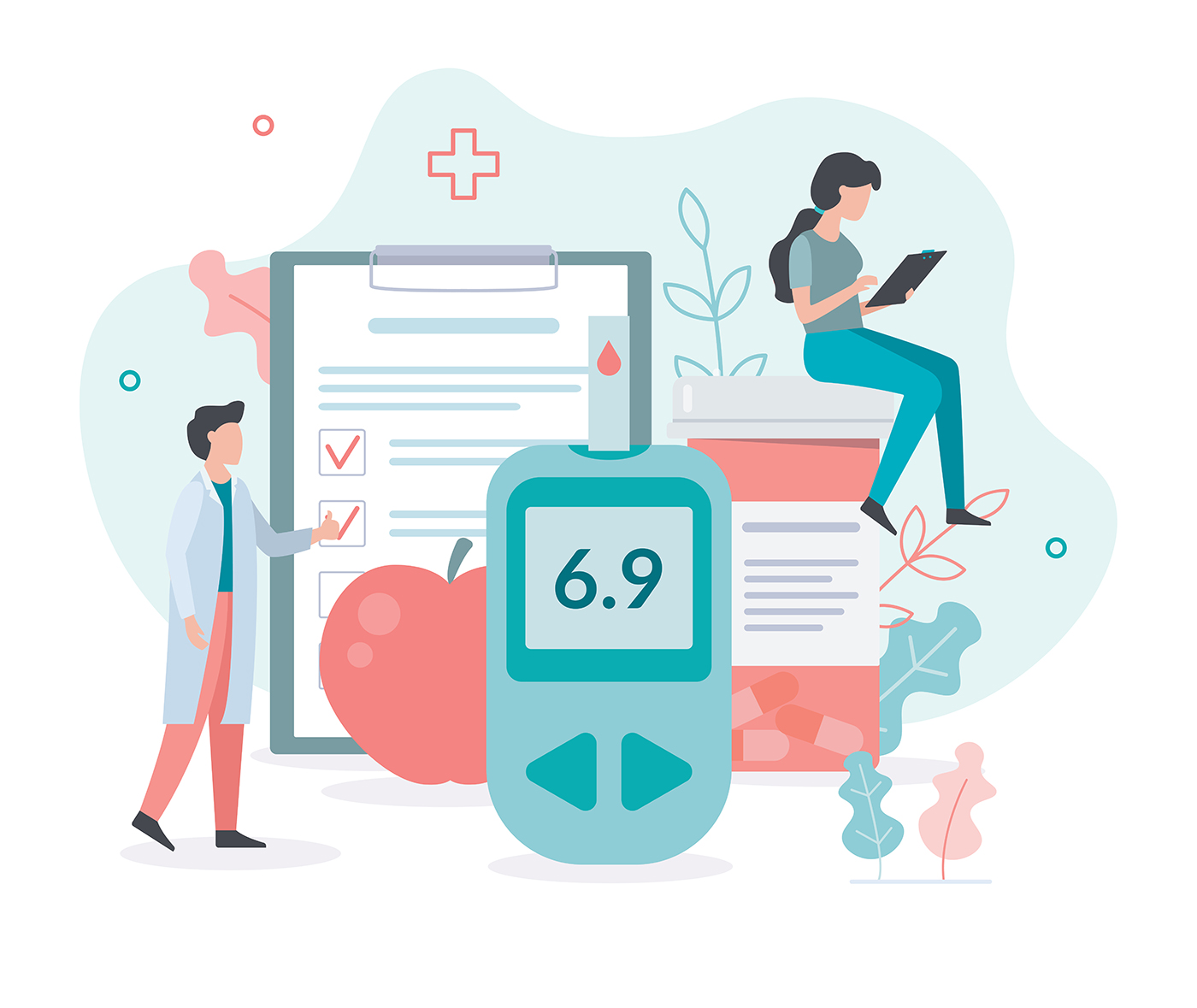Diabetes and
Insulin ResistanceRecent estimates suggest that approximately one out of three U.S. citizens are insulin resistant and nearly ten percent have diabetes (1).
A Brief Look at
Diabetes
Recent estimates suggest that approximately one out of three U.S. citizens are insulin resistant and nearly ten percent have diabetes (1). Additionally, more than one-third of diabetes cases go undiagnosed (2). Blood glucose homeostasis, primarily regulated by insulin, is one of the most important metabolic functions in the body. Dysfunction of maintaining blood glucose levels significantly increases risk for developing cardiovascular disease, among countless other chronic health issues (3). Fortunately, most insulin-related conditions are highly treatable or even reversible, and your Prime Meridian HealthCare professional is available to teach you how.

The Role of Insulin
Insulin is
vitally important for life as our main anabolic (cellular growth) hormone and the primary means to control the use and storage of glucose. As a hormone, insulin is the chemical messenger that facilitates the cellular uptake of glucose (sugar) into your muscles, fat, and liver so that it can be used for immediate needs and stored for future use. In a sense, insulin is the key that opens up our cells to all that glucose circulating in our bloodstream; without it our blood glucose levels just remain chronically high for no reason
insulin Also
– Helps regulate the transportation of amino acids into muscle tissue for growth and repair.
– Facilitates lipid metabolism, promoting synthesis of fatty acids in the liver and inhibiting the breakdown of fat in our energy storage (adipose) cells.
– Aids in the uptake of certain nutrients (ie. potassium, magnesium and phosphate) into our cells.
– Manages excretion of sodium and helps to regulate fluid volume in the urine.
Without insulin,
our bodies are unable to use glucose as energy and to facilitate muscular repair and growth. However, our entire metabolic system is dependent on homeostasis; a steady and consistent production and secretion so that our pancreas is not overworked and that our cells remain sensitive to its effects. Unfortunately, issues can arise that prevent homeostasis such as insulin resistance
The Cycle of Resistance
As the name suggests, insulin resistance occurs when your muscles, fat, and liver become impaired in their ability to respond to the insulin secreted from your pancreas. The development of insulin resistance lies at the heart of problems with the human metabolic process. During digestion, food is broken down into glucose so that it may be utilized as energy by the brain and muscles. With only so much storage space in the brain and muscles for glucose, the pancreas must secrete insulin to shuttle the additional sugar to adipose tissue to be stored for future times of famine. In reaction to continual blood glucose hikes, the pancreas is forced to produce more and more insulin, which over time weakens its inherent ability and makes the cells resistant to the hormone’s influence. The resistant cells require more insulin to transport the glucose but the overworked pancreas can no longer keep up with the demand. When this condition lingers, it damages the vessels that supply blood to vital organs increasing risk for numerous long-term health issues. The primary determinant of insulin resistance is hyperglycemia, a condition characterized by chronically elevated blood glucose levels.
Insulin resistance is characterized by certain symptoms:
Acute Symptoms: thirst, headache, trouble focusing, blurred vision, fatigue, frequent urination
Chronic Symptoms: unexplained weight loss, slow healing, skin infections, vision issues, nerve damage (cold or insensitive extremities), gastrointestinal issues
Note that while hyperglycemia is the primary factor, testing for several related biomarkers, including fasting blood glucose levels, A1c (determination of average blood glucose levels over a 2-3 month period), triglycerides, and LDL (“bad”) and HDL (“good”) cholesterol levels, may be involved in a diagnosis of insulin resistance. Also, an individual may have insulin resistance for years and never notice any signs, which is one reason why an annual comprehensive blood panel is so important.
THE PROGRESSION
INSULIN RESISTANCE TO DIABETES
INSULIN RESISTANCE
is a progressive condition. Initially, increased production and secretion of insulin will make up for the lack of cellular sensitivity, and blood sugar levels will remain somewhat normal. If resistance is not addressed through lifestyle changes, eventually the cellular uptake reduces to the point where the pancreas will be unable to produce enough insulin to regulate blood sugar levels. Current estimates suggest that more than half of insulin resistance diagnoses eventually progress to diabetes (4).
HEALTHY LEVELS
“Normal” fasting (after an 8+ hour fast) blood glucose levels are <100mg/dl and <140mg/dl two hours after a meal.
A1c, a reflection of the average blood glucose levels over a long term (2-3 months), >5.7%.
PRE-DIABETES
Fasting blood glucose of 100mg/dl-125mg/dl and A1c of 5.7% – 6.4%.
DIABETES
Fasting blood glucose <125mg/dl and A1c of <6.4%.
The signs of diabetes are similar to that of insulin resistance, just more lingering and extreme. If you are experiencing any of the aforementioned symptoms, especially frequent infections and difficult healing, it is time to contact Prime Meridian Healthcare for a consultation regarding your metabolic health.
References
1
Diabetes Burden in the United States
Centers for Disease Control
4
High-Risk State for Developing Diabetes
Tabak A., et al.
2
Trends of Diabetes Amoung Adults in the United States
Menke A., et al.


